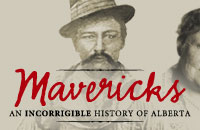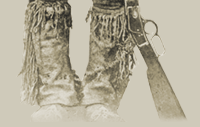|

[ Project Plans | Essential
Questions | Knowledge Hunt | Glossary | Links ]
Art of the Western Identity
Using the Paintings of Marion Nicoll and A.C. Leighton to Compare
Their Depiction of the West
Introduction
Students need to explore the unique and dynamic relationship humans
have with the land and how places and environments affect our understanding
of citizenship and identity. Students will examine the impact of
physical geography and their own connections to the land as to how
it impacts our view of Western Canada. How do we see the "land"?
How does it affect how we see ourselves? How has the land changed
since Leighton started painting in the 1930s? How would you represent
the West as you see it? What would you want to show to the world?
Project Explanation
In this project, students will develop an appreciation of how different
artists may view the same subject in extremely different ways. They
will research and compare two different artists and their artistic
styles, creating an interpretation of one of their artworks. Students
will then try to emulate the style of one of the artists by creating
their own artistic representation of Western Canada and Alberta.
Alberta Social Studies Curriculum Unit Connections
Grade Four - Alberta: The Land, Histories and Stories
4.1 Alberta: A Sense of the Land
4.2 The Stories, Histories and People of Alberta
4.3 Alberta: Celebrations and Challenges
Grade Five - Canada: The Land, Histories and Stories
5.1 Physical Geography of Canada
Materials and Resources Needed
Procedures
Students will examine and interpret two very different artists,
artistic styles and the ways they represented life in the Canadian
West. A. C. Leighton was one of the most influential artists in
Alberta and Marion Nicoll learned under Leighton's tutelage.
Leighton focused mainly on the Canadian Wilderness, while Nicoll
began with landscape paintings and later turned to "classical
abstractionism."
Using the Mavericks: An Incorrigible History of Alberta
site and the other web resources presented above, students will
research about the two artists and their artistic styles. They will
then carefully examine and appraise the different artworks of each
painter. Each student should choose one painting from each artist
to study, and then use any of the following questions they feel
are appropriate to write an interpretation of the artwork. Their
work should use a "journal" style where they use questions
from below that fit their painting. They should be as descriptive
as possible in their writing, elaborating on the important questions.
Looking at Western Art
- What do you see in the artwork?
- What lines, shapes, colours, and textures are used in the
artwork?
- What objects are included? Describe them.
- Are people in the artwork? What do they look like? What are
they doing?
- Is the artwork a natural scene? Describe what it looks like.
- What materials were used to create it? What is its actual
size?
- How is everything in the artwork arranged?
- What is the very first thing that catches your eye?
- How are the elements connected? Does anything repeat?
- What is the most important colour, shape or object? Why?
- Do some things appear to be close and others far away? How
does the artist accomplish this?
- What is the artwork all about?
- Imagine you are at the scene of this artwork. How do you feel
being there?
- What sounds do you hear around you?
- What can you smell if you were there?
- What could you taste if you were there?
- What does this artwork remind you of?
- What is the "story" behind this artwork?
- What do you think the artist is trying to tell you through
this artwork?
- How would you critique this artwork?
- Is this a good work of art? Why or why not?
- What do you like the most about this artwork?
- What would you change if you were the artist?
- How is it stereotypical?
- Does it show what is the "West" is really like
to someone who has never been to Alberta?
- How does it portray our province? What would it tell tourists
about Alberta?
- What kind of artwork would you choose to create in order to
show the "Real West" to others?
Once the student interpretations are complete, they should share
their own writing and discuss whether other people looked at the
artwork in the same way. This may lead to some great discussions,
especially using Nicoll's paintings, about subjectivity in
art.
Students will now attempt to create an artwork in the style of
one or both painters. They could work from a photograph from the
ImagesCanada website (searching "mountains" provides
2961 black & white photos), photos from calendars, other artworks,
or even their own. Paintings in the style of Leighton may be done
with watercolour or tempera paints. "Paintings" in the
style of Nicoll could be created by cutting pieces of coloured paper
and pasting them onto a coloured background.
Finally, the students will write a written description of their
work, what they tried to represent, what the "subject"
means to them, what they liked about these styles and what they
found difficult. Their artworks may be exhibited along with their
writing.
Assessment and Evaluation
- After the teacher and students collaboratively create a rubric,
students should use it as a guide for their learning as they are
working through the process, regularly checking that all the needed
elements are included in their work and revising as needed. The
rubric can then be used as a formal evaluative tool when they
have completed their project.
- Students may use their rubric as a guide for writing a self-assessment
of their project work. They will determine their level for each
of the categories and use the criteria specified in their rubric
to justify them.
- A project journal may be used for information gathering as well
as for reflective writing as the process is taking place. Students
can pose questions, vent frustrations, synthesize their work,
examine their process, and even wonder about what they are missing
or what is still needed for their project. This may be completed
as a group or individually.
Ideas for Enriching this Project
- Students may research and examine other Alberta artists, such
as Margaret
Shelton and compare their work to Nicoll and Leighton
- Students could examine the work of the Group of Seven and describe
how they tried to portray the Canadian West
 |



![]()
